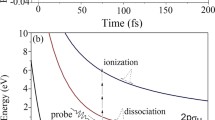Abstract
A theoretical approach to IR-laser induced dissociation and desorption is described which is based on the generally recognized fact that vibrational energy is mainly transferred on the short range repulsive core of the interaction potential. Because of the shortness of the range, it may be assumed that the motion relevant for the vibrational energy transfer takes place on an element dS of the potential surface which is of small dimensions as compared to those of molecules. The Hamiltonian can be transformed into the form which enables elimination of coordinates which are nearly cyclic on dS and to derive the equation of motion for the distance perpendicular to dS which may be regarded as the relevant generalized coordinate for the problem. Its motion is quantized, and the quantum mechanical transition probabilities must be averaged over different surface elements dS. The theory readily reproduces the most striking features of the vibrational predissociation of complexes like Ar.HCl and Ar.HD. It allows physical insight and can also be implemented on more complex systems where presently no other theoretical methods are available.
Similar content being viewed by others
References
Cannon B D and Smith I W M 1984Chem. Phys. 83 429
Hutson J M 1984J. Chem. Phys. 81 2357
Miklavc A 1980aJ. Chem. Phys. 72 3805
Miklavc A 1980bMol Phys. 39 855
Miklavc A 1983J. Chem. Phys. 78 4502
Miklavc A 1987Surf. Sci. 180 379
Miklavc A and Fischer S F 1978J. Chem. Phys. 69 281
Miklavc A, Kocjan D, Avbelj F and Hadzi D 1988J. Chem. Soc., Faraday Trans. II 84 763
Miklavc A and Smith I W M 1988J. Chem. Soc. Faraday Trans. II 84 227
Moore C B 1965Chem. Phys. 43 2979
Nikitin E E 1967Teor. Exp. Khim., Akad. Nauk. Ukr. SSR,3 185
Author information
Authors and Affiliations
Rights and permissions
About this article
Cite this article
Miklavc, A. Theoretical aspects of IR-laser induced dissociation and desorption processes. Proc. Indian Acad. Sci. (Chem. Sci.) 103, 363–367 (1991). https://doi.org/10.1007/BF02842091
Issue Date:
DOI: https://doi.org/10.1007/BF02842091




